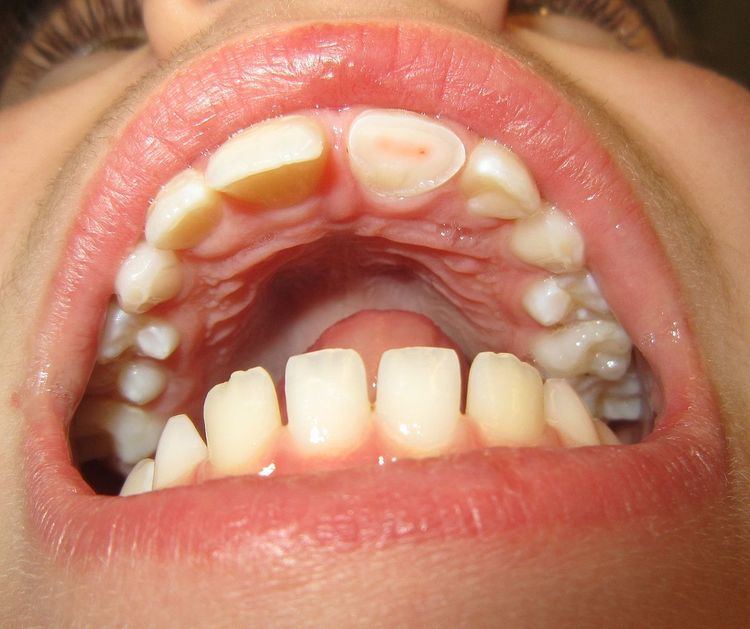 | ||
Dental trauma refers to trauma (injury) to the teeth and/or periodontium (gums, periodontal ligament, alveolar bone), and nearby soft tissues such as the lips, tongue, etc. The study of dental trauma is called dental traumatology.
Contents
Prevalence
Dental trauma is most common in younger people, accounting for 17% of injuries to the body in those aged 0–6 years compared to an average of 5% across all ages. It is more frequently observed in males compared to females. Traumatic dental injuries are more common in permanent teeth compared to deciduous teeth and usually involve the front teeth of the upper jaw.
Types
Risk factors
Prevention
Regular use of a mouthguard during sports and other high-risk activities (such as military training) is the most effective prevention for dental trauma. However, studies in various high-risk populations for dental injuries have repeatedly reported low compliance of individuals for the regular using of mouthguard during activities. Moreover, even with regular use, effectiveness of prevention of dental injuries is not complete, and injuries can still occur even when mouthguards are used as users are not always aware of the best makes or size, which inevitably result in a poor fit.
Management and future treatment options
The management depends on the type of injury involved and whether it is a baby or an adult tooth. The Dental Trauma Guide is an evidence-based and up-to-date resource to aid management of dental trauma. If teeth are completely knocked out baby front teeth should not be replaced. The area should be cleaned gently and the child brought to see a dentist. Adult front teeth (which usually erupt at around 6 years of age) can be replaced immediately if clean. See below and the Dental Trauma Guide website for more details. If a tooth is avulsed, make sure it is a permanent tooth (primary teeth should not be replanted, and instead the injury site should be cleaned to allow the adult tooth to begin to erupt).
The poster "Save a Tooth" is written for the public and is available in several languages—Spanish, English, Portuguese, French, Icelandic, Italian—and can be obtained at the IADT website.
For other injuries, it is important to keep the area clean - by using a soft toothbrush and antiseptic mouthwash such as chlorhexidine gluconate. Soft foods and avoidance of contact sports it also recommended in the short term. Dental care should be sought as quickly as possible.
Primary dentition
Potential sequelae can involve pulpal necrosis, pulp obliteration and root resorption. Necrosis is the most common complication and an assessment is generally made based on colour supplemented with radiograph monitoring. A change in colour may mean the tooth is still vital but if persists likely to be non-vital.
When the injured teeth are painful with function due to damage to the periodontal ligaments (e.g., dental subluxation), a temporary splinting of the injured teeth may relieve the pain and enhance eating ability. An avulsed permanent tooth should be gently rinsed under tap water and immediately re-planted in its original socket within the alveolar bone and later temporarily splinted by a dentist. Failure to re-plant the avulsed tooth within the first 40 minutes after the injury may result in very poor prognosis for the tooth. Management of injured primary teeth differs from management of permanent teeth; an avulsed primary tooth should not be re-planted (to avoid damage to the permanent dental crypt).
